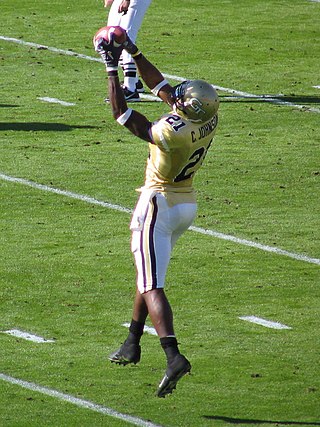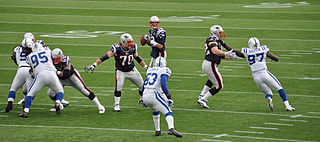
In gridiron football, a lineman is a player who specializes in play at the line of scrimmage. The linemen of the team currently in possession of the ball are the offensive line, while linemen on the opposing team are the defensive line. A number of NFL rules specifically address restrictions and requirements for the offensive line, whose job is to help protect the quarterback from getting sacked for a loss, or worse, fumbling. The defensive line is covered by the same rules that apply to all defensive players. Linemen are usually the largest players on the field in both height and weight, since their positions usually require less running and more strength than skill positions.

A cornerback (CB) is a member of the defensive backfield or secondary in gridiron football. Cornerbacks cover receivers most of the time, but also blitz and defend against such offensive running plays as sweeps and reverses. They create turnovers through hard tackles, interceptions, and deflecting forward passes.

Linebacker (LB) is a playing position in gridiron football. Linebackers are members of the defensive team, and line up three to five yards behind the line of scrimmage and the defensive linemen. They are the "middle ground" of defenders, playing closer to the line of scrimmage than the defensive backs (secondary), but farther back than the defensive linemen.

A wide receiver (WR), also referred to as a wideout, and historically known as a split end (SE) or flanker (FL), is an eligible receiver in gridiron football. A key skill position of the offense, WR gets its name from the player being split out "wide", farthest away from the rest of the offensive formation.
In gridiron football, blitzing is a tactic used by the defense to disrupt pass attempts by the offense. During a blitz, a higher than usual number of defensive players will rush the opposing quarterback, in an attempt either to tackle them or force them to hurry their pass attempt.
Strategy forms a major part of American football.

The 46 defense is an American football defensive formation, an eight men in the box defense, with six players along the line of scrimmage. There are two players at linebacker depth playing linebacker technique, and then three defensive backs. The 46 defense was originally developed and popularized with the Chicago Bears by their defensive coordinator Buddy Ryan, who later became head coach of the Philadelphia Eagles and Arizona Cardinals.
A formation in American football refers to the position players line up in before the start of a down. There are both offensive and defensive formations and there are many formations in both categories. Sometimes, formations are referred to as packages.
In American football, a zone blitz is a defensive tactic that sends additional players to rush the opposing team's quarterback, whilst also unexpectedly redirecting a supposed pass rushing player into pass coverage instead. This tactic also includes zone coverage.

The passing pocket, or the pocket, is a term used in American football to describe the area in the backfield created on a passing play where the offensive line forms a wall of protection around the quarterback. This allows him adequate time to find an open receiver and to pass the ball. The offensive line will drop back slightly, creating a U-shaped protected area for the quarterback to find an open receiver and pass the ball.
A trick play, also known as a gadget play, gimmick play or trickeration, is a play in gridiron football that uses deception and unorthodox tactics to fool the opposing team. A trick play is often risky, offering the potential for a large gain or a touchdown if it is successful, but with the chance of a significant loss of yards or a turnover if not. Trick plays are rarely used not only because of the riskiness, but also to maintain the element of surprise for when they are used.

A halfback (HB) is an offensive position in American football, whose duties involve lining up in the offensive backfield and carrying the ball on most rushing plays, i.e. a running back. When the principal ball carrier lines up deep in the backfield, and especially when that player is placed behind another player (usually a blocking back), as in the I formation, that player is instead referred to as a tailback (TB).

In American football, the specific role that a player takes on the field is referred to as their "position". Under the modern rules of American football, both teams are allowed 11 players on the field at one time and have "unlimited free substitutions", meaning that they may change any number of players during any "dead ball" situation. This has resulted in the development of three task-specific "platoons" of players within any single team: the offense, the defense, and the so-called 'special teams'. Within these three separate "platoons", various positions exist depending on the jobs that the players are doing.

The flexbone formation is an offensive formation in American football that includes a quarterback, five offensive linemen, three running backs, and varying numbers of tight ends and wide receivers. The flexbone formation is derived from the wishbone formation and features a quarterback under center with a fullback lined up directly behind the quarterback. There are two smaller running backs called slotbacks aligned behind the line of scrimmage on each side of the offensive line. The slotbacks are sometimes incorrectly referred to as wingbacks. But in order to be a wingback, there must be a guard, tackle and tight end all on one side of the center on the line of scrimmage and then the wingback off the line of scrimmage.

The triple option is an American football play used to offer six ways to move the football forward on the field of play. The triple option is based on the option run, but uses three players who might run with the ball instead of the two used in a standard option run.
In American football, a play is a close-to-the-ground plan of action or strategy used to move the ball down the field. A play begins at either the snap from the center or at kickoff. Most commonly, plays occur at the snap during a down. These plays range from basic to very intricate. Football players keep a record of these plays in a playbook.

Zone coverage is a defense scheme in gridiron football used to protect against the pass.
The following terms are used in American football, both conventional and indoor. Some of these terms are also in use in Canadian football; for a list of terms unique to that code, see Glossary of Canadian football.

A route is a pattern or path that a receiver in gridiron football runs to get open for a forward pass. Routes are usually run by wide receivers, running backs and tight ends, but other positions can act as a receiver given the play.












